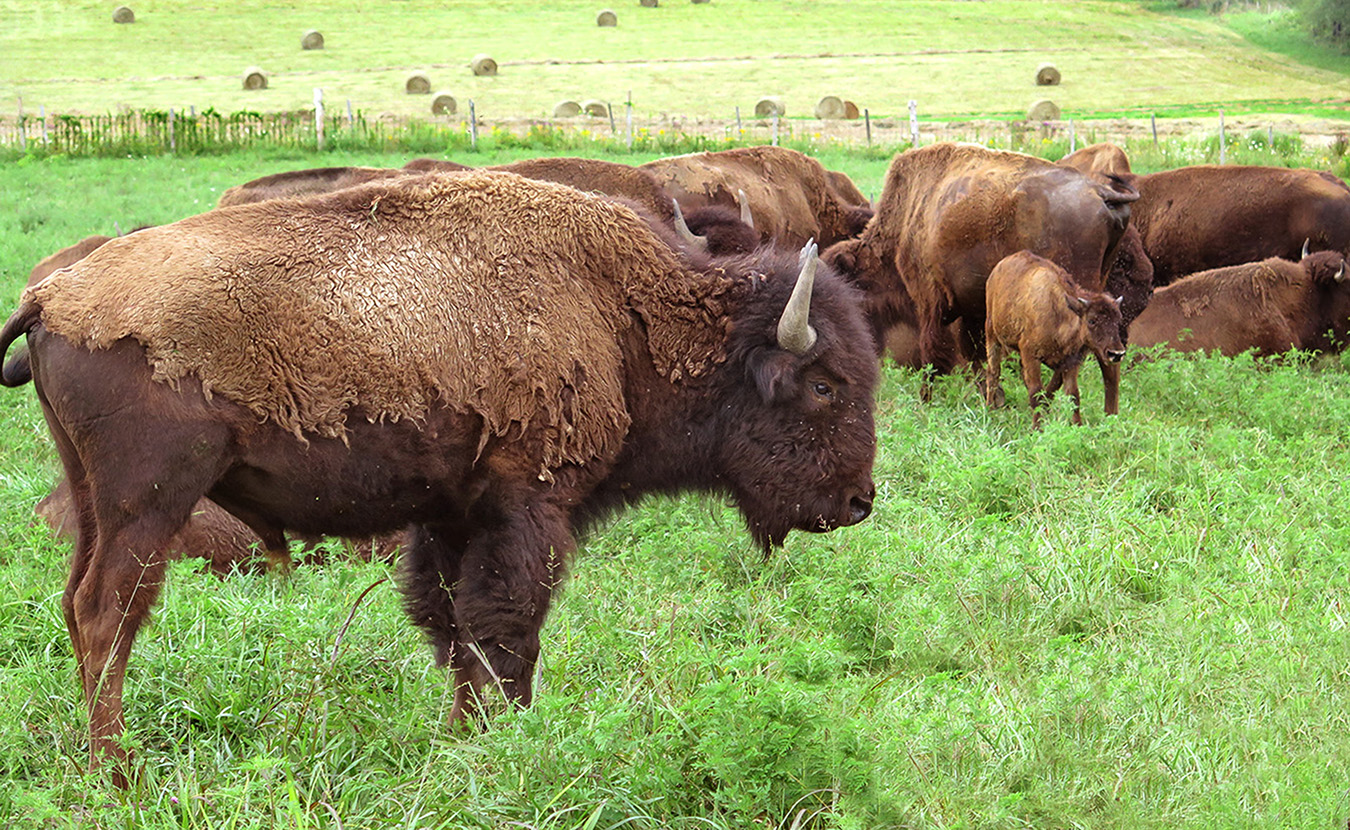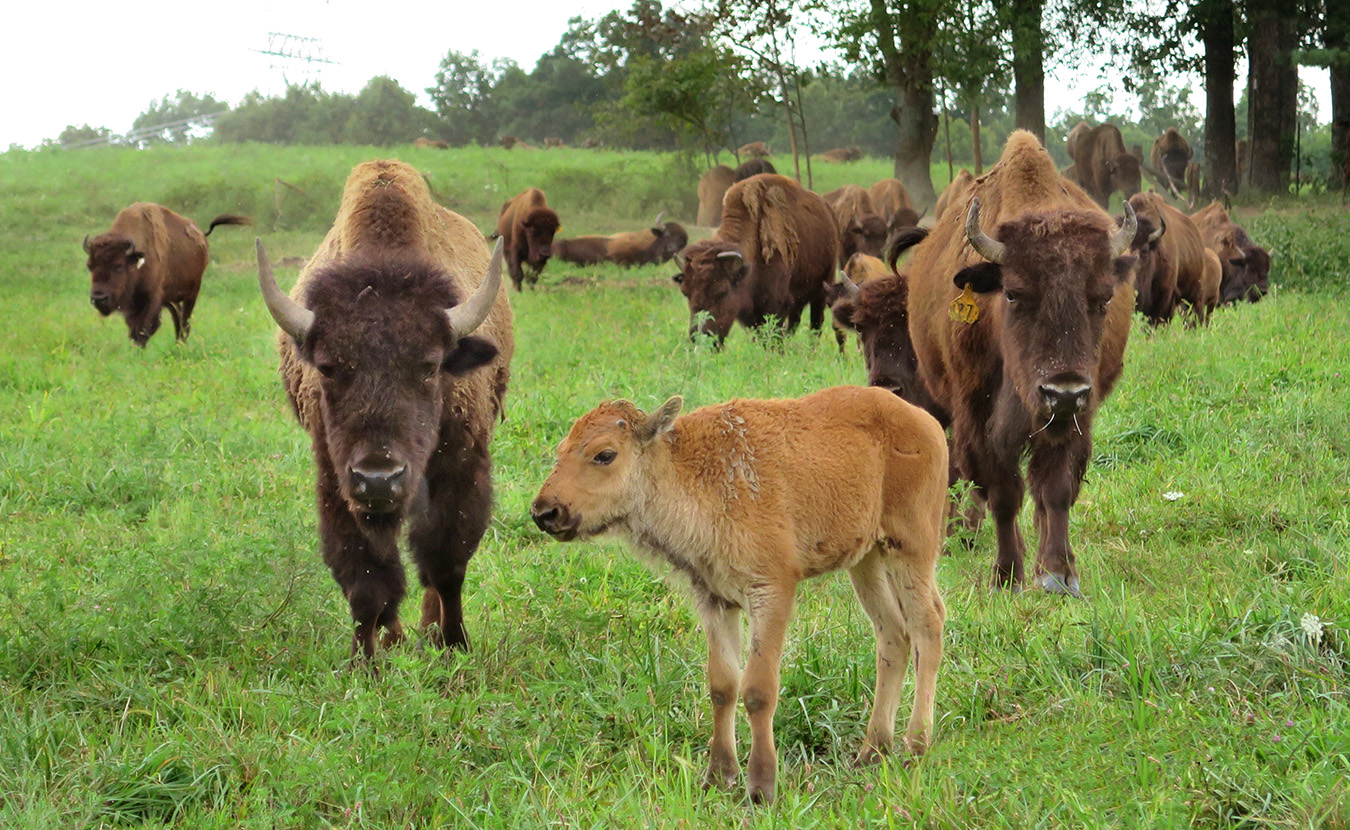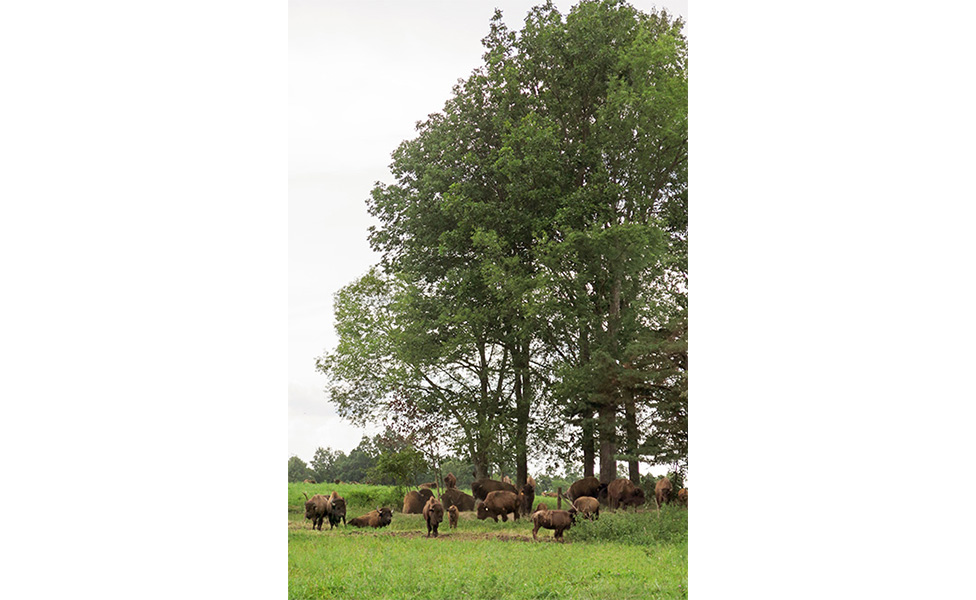The association between the state of Indiana and the American bison (or buffalo, as it’s commonly called) is long and well known. The animal appears on the official state seal and even shows up on an early version from the dawn of the 19th century, when Indiana was still a territory governed by future U.S. president William Henry Harrison.
The seal looked different then, but the basic elements — a rising/setting sun (much debate has occurred over this facet of the seal), a forest, a woodsman, and a fleeing bison — were all there. And although bison were hunted nearly to extinction as civilization and industry spread across the Midwest and West, the animal remained on the seal, whose current version was adopted in 1963.
Bison are on the comeback trail, however, says Zach Martin, owner of the 225-acre Red Frazier Bison Ranch in Greene County. Thanks to the efforts of the government and private individuals, America is once again a land where the buffalo roam, just in time for the state of Indiana’s bicentennial next year. Indiana has several bison ranches, the largest of which – Cook’s Bison Ranch in Wolcottville – boasts 500 head of bison grazing on 750 acres of land, according to co-owner Suzy Corkins. Cook’s also owns a 1,440-acre ranch in North Dakota that is home to a 1,300-head herd. Red Frazier, meanwhile, has about 60 bison grazing its picturesque pastures. “We’re maybe the fifth-largest ranch in the state,” Martin estimates.
Today’s bison population is a far cry from the species’ heyday prior to 1600, when 30 to 60 million animals roamed North America. But scarcity is of little concern, Martin says, “because of private ranchers … who took on the burden of building the population back up over the past two decades. The population is in the 350,000 to 400,000 range right now. And that continues to grow because more ranchers are getting involved. I don’t see that trend going anywhere but up.”
This growth is being fueled by the surging popularity of bison meat as a more natural, nutritional alternative to beef — much of which comes from cattle pumped full of antibiotics and growth hormones; raised in cramped, cruel, factory-like conditions; and force-fed corn grain instead of being allowed to graze naturally. Bison meat has a denser concentration of nutrients and lower fat content than beef, as well as a denser texture and slightly sweeter taste, Martin says.
“It’s a red meat that has a lower fat percentage than some of the healthier white meats,” such as chicken breast and salmon, he says. According to the National Bison Association, there are 2.42 grams of fat in a 100-gram serving of cooked bison meat, compared to 10.15 grams in the same amount of beef and 10.97 in a similar serving of salmon. “And a lot of people with heart disease, cholesterol issues, things like that, will be able to process the bison much better.”
Lower fat content means many people cook bison meat at a lower temperature, which gives it that sweeter taste. It also means that diners need to be comfortable eating a medium to medium-rare burger, steak, or other cut of bison meat.
“If you don’t know how to prepare it, you won’t like it,” Martin says. “A medium-well bison steak is terrible. It’s because you’ve cooked the fat out of it. I’d say that’s the only negative” to bison meat.
Martin’s favorite cut is the simplest: a straight-grilled ribeye “with minimal salt and pepper, nice and meaty, medium-rare, super basic. But, man, I also love a good bison burger — cooked properly, medium-rare — it’s amazing. The texture is like nothing you’d expect, not like an overly processed beef burger. It’s fantastic.” Red Frazier butchers cut their bison meat to suit your personal cooking preferences at their retail outlet in Bloomington (840 W. 17th St., Suite 9). You can also purchase their precut meat at the Bloomington Community Farmers’ Market.
Martin says consuming bison meat also means “there’s more of a guarantee that you’re not ingesting the unknown effects of growth hormones and excessive antibiotics.”
More American Than Cattle
Without human intervention, cattle “wouldn’t be around; they’d be extinct,” Martin says. He should know. He grew up working on his grandfather’s farm and would occasionally help the neighbors, who ran a large cattle operation. He witnessed first-hand how the commercialization of the cattle industry has led to processing and reproductive innovations that are now drawing the cold shoulder of health-conscious consumers.
“We’ve dumbed them down with breeding practices over the years to the point where they can’t do much on instinct anymore,” Martin says. “That is not the case with bison. They are very curious and intelligent animals — and that’s why they’re so difficult to handle.”
Bison are fast, powerful, agile, and quick to flee if cornered. They have a vertical leap of more than six feet. The bison’s keen survival instincts are the number one difference between handling bison and cattle. Martin says loading facilities need to have tall, thick steel barriers, “with a squeeze-chute system that is much more intense than anything that would be considered for cattle.” Out in the pasture, fences need to be at least five to six feet high, with larger posts spaced closer together. These measures are about protecting the animals as well as the ranchers handling them, Martin explains. “Humans are much slower [than bison], and sometimes, we’re in the way. That’s when people get hurt.”
Bison are one of the most spiritually revered animals among the Native American people who occupied most of what would become the United States prior to the arrival of European settlers, who introduced the first cows to the continent.
“You look into a beef cattle’s eyes and you see a blank stare,” Martin says. “You look at a bison — I swear, if we could figure out a way to communicate with them — it’s no wonder they’ve been able to survive for centuries. The more and more I watch them, the more I learn.”






